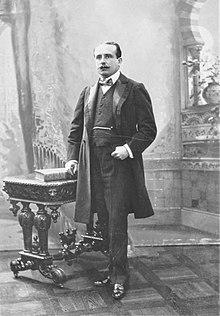Loading AI tools
President of Peru variously in the early 20th century From Wikipedia, the free encyclopedia
José Simón Pardo y Barreda (February 24, 1864 – August 3, 1947)[1] was a Peruvian politician who served as the 35th (1904–1908) and 39th (1915–1919) President of Peru.
This article needs additional citations for verification. (September 2014) |
José Pardo | |
|---|---|
 | |
| 35th President of Peru | |
| In office September 24, 1904 – September 24, 1908 | |
| Prime Minister | Augusto Bernardino Leguía y Salcedo Agustín Tovar Carlos A. Washburn Salas |
| Vice President | José Salvador Cavero Ovalle Serapio Calderón |
| Preceded by | Serapio Calderón |
| Succeeded by | Augusto B. Leguía |
| 39th President of Peru | |
| In office August 18, 1915 – July 4, 1919 | |
| Prime Minister | Carlos Isaac Abril Galindo Enrique de la Riva-Agüero y Looz Corswaren Francisco Tudela y Varela Germán Arenas y Loayza Juan Manuel Zuloaga |
| Vice President | Ricardo Bentín Sánchez Melitón Carvajal |
| Preceded by | Oscar Benavides |
| Succeeded by | Augusto B. Leguía |
| Prime Minister of Peru | |
| In office September 8, 1903 – May 14, 1904 | |
| President | Manuel Candamo |
| Preceded by | Eugenio Larrabure y Unanue |
| Succeeded by | Alberto Elmore Fernández de Córdoba |
| Personal details | |
| Born | José Simón Pardo y Barreda 24 February 1864 Lima, Peru |
| Died | 3 August 1947 (aged 83) Lima, Peru |
| Political party | Civilista Party |
| Occupation | Politician |
| Signature | |
Born in Lima, Peru, he was the son of Manuel Justo Pardo y Lavalle, who had been the first civilian president of Peru (1872-1876) and the founder the Civilista Party; he is one of two second-generation Peruvian presidents (Manuel Prado, son of former dictator Mariano Ignacio Prado, is the other). His grandfather, Felipe Pardo y Aliaga (1806-1868), was a distinguished diplomat, writer and politician who was also Foreign Minister and Vice President of the Peruvian Council of State before, during and after the presidencies of Vivanco and Castilla.
José Pardo headed the Civilista Party and was Foreign Minister under Eduardo López de Romaña and then Prime Minister (1903-1904) under Manuel Candamo. After Candamo's death, Serapio Calderón became the interim president and called for new elections. The Civilista Party named José Pardo as its candidate, while the Democratic Party presented the candidacy of Nicolás de Piérola, who retired early before the elections mentioning a "lack of guarantees." This fact led Pardo to become elected. Both his presidential terms were marked by liberal politics.
His government was marked by pushing for better education for all Peruvians. The elementary education in Peru, according to the Law of 1876 proposed by his father, Manuel Pardo, was under the responsibility of the municipalities throughout the country. José Pardo, under his Secretary of Justice and instruction, decided to confront the problem.
The law promulgated in 1905 reformed the education system to depend on the Central Government. It also called for primary education to be free and compulsory in far away places such as villages and mines, and that at least a small school for all children be located in any place with more than two hundred inhabitants. The Escuela Normal de Varones ("Normal school for males") was founded for the formation of male teachers, as well as the Escuela Normal de Mujeres ("Normal school for females").
Pardo created a General Branch of Instruction to where inspectors in charge of the work of surveillance in the whole Republic depended. In the cultural field the following were established: The National Academy of History, the School of Fine Arts (Bellas Artes), the National Academy of Music, and the National Museum of History. The superior combat school was also founded to form major state officers.
During his second government José Pardo confronted the consequences of the First World War, as well as the labor agitation for the obtainment of the "8 working hours" a day. It was finally granted on January 15, 1919.
With barely a month before the end of his second term, he was ousted in a coup by Augusto B. Leguía. He spent the next eleven years in exile in the South of France, until his return to Lima. He died there in 1947.
In 1900, Pardo married his first cousin, Carmen Heeren Barreda. The marriage produced seven children: Manuel, José (the Marquis of Fuente Hermosa de Miranda, until his death in 1999), Enrique, Carmen, Juan, Oscar and Felipe. The current Marquis, José Pardo Paredes (born 1947), is one of President Jose Pardo's grandchildren.
Seamless Wikipedia browsing. On steroids.
Every time you click a link to Wikipedia, Wiktionary or Wikiquote in your browser's search results, it will show the modern Wikiwand interface.
Wikiwand extension is a five stars, simple, with minimum permission required to keep your browsing private, safe and transparent.